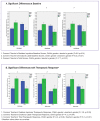Therapeutic Response to Methylphenidate in ADHD: Role of Child and Observer Gender
- PMID: 32194651
- PMCID: PMC7065565
Therapeutic Response to Methylphenidate in ADHD: Role of Child and Observer Gender
Abstract
Objective: This study aims to examine the interaction between the gender of the child and the gender of the observers (teachers, parents) on the therapeutic response (TR) noted with methylphenidate (MPH) in children with ADHD.
Method: Children with ADHD participated in a two week double-blind, randomized, cross-over clinical trial with MPH and placebo, and the difference between the week of treatment with MPH and placebo was calculated for each measure to obtain the treatment response (TR) with MPH. The TR for differences based on the gender of child and the observer was examined by using a univariate analysis of covariance (ANCOVA).
Results: 299 children (269-male, 30-female; average age 8.9±1.8 years) were evaluated by 52 male teachers, 212 female teachers; 269 female parents and 30 male parents. For the baseline week, the ANCOVA analysis for teachers yielded a significant teacher's gender x child's gender interaction. For the evaluation of TR, the ANCOVA analysis revealed a significant teacher's gender x child's gender interaction whereas no parent's gender x child's gender interactions were noted, all noted interactions were of a small effect size (eta squared <0.02).
Conclusions: These results suggest that there are differences in symptom assessment between parents and teachers at baseline and with TR based on the gender of the observer and the child. While clinicians need to be aware of these interactions, it remains unclear if these interactions will be clinically useful due to the small effect sizes.
Objectif: La présente étude vise à examiner l’interaction entre le sexe de l’enfant et le sexe des observateurs (enseignants, parents) dans le cadre de la réponse thérapeutique (RT) notée au méthylphénidate (MPH) chez les enfants souffrant du trouble de déficit de l’attention avec hyperactivité (TDAH).
Méthode: Des enfants souffrant du TDAH ont participé à un essai clinique randomisé croisé de deux semaines à double insu avec MPH et placebo, et la différence entre la semaine de traitement avec MPH et celle avec placebo a été calculée pour chaque mesure afin d’obtenir la réponse au traitement (RT) avec MPH. La RT pour les différences basées sur le sexe de l’enfant et de l’observateur a été examinée à l’aide d’une analyse univariée de la variance (ANCOVA).
Résultats: Deux cent quatre-vingt-dix-neuf enfants (269 garçons, 30 filles; âge moyen 8,9±1,8 ans) ont été évalués par 52 enseignants de sexe masculin, 212 enseignantes de sexe féminin; 269 parents de sexe féminin et 30 parents de sexe masculin. Pour la semaine de départ, l’analyse ANCOVA des enseignants a dégagé une interaction significative entre le sexe de l’enseignant et le sexe de l’enfant. Pour l’évaluation des RT, l’analyse ANCOVA a révélé une interaction significative entre le sexe de l’enseignant et le sexe de l’enfant, alors qu’aucune interaction n’a été notée entre le sexe d’un parent et le sexe de l’enfant. Toutes les interactions notées étaient d’une petite taille de l’effet (êta carré < 0,02).
Conclusions: Ces résultats suggèrent qu’il y a des différences d’évaluation des symptômes entre parents et enseignants au départ, et de la RT selon le sexe de l’observateur et le sexe de l’enfant. Bien que les cliniciens doivent être conscients de ces interactions, il demeure incertain si ces interactions seront utiles sur le plan clinique en raison des petites tailles de l’effet.
Keywords: ADHD; child gender; methylphenidate; observer gender; therapeutic response.
Copyright © 2020 Canadian Academy of Child and Adolescent Psychiatry.
Figures
References
-
- Abikoff HB, Jensen PS, Arnold LE, Hoza B, Hechtman L, Pollack S, Hinshaw S. Observed classroom behavior of children with ADHD: Relationship to gender and comorbidity. Journal of Abnormal Child Psychology. 2002;30(4):349–359. - PubMed
-
- Achenbach TM, McConaughy SH, Howell CT. Child/ adolescent behavioral and emotional problems: Implications of cross-informant correlations for situational specificity. Psychological Bulletin. 1987;101(2):213. - PubMed
-
- American Psychiatric Association. Diagnostic and statistical manual of mental disorders. 4th ed, Text Revision. Washington, DC: Author; 2000.
-
- Antrop I, Roeyers H, Oosterlaan J, Van Oost P. Agreement between parent and teacher ratings of disruptive behavior disorders in children with clinically diagnosed ADHD. Journal of Psychopathology and Behavioral Assessment. 2002;24(1):67–73.
-
- Arcia E, Conners CK. Gender differences in ADHD? Journal of Developmental and Behavioral Pediatrics. 1998;19(12):77–83. - PubMed
LinkOut - more resources
Full Text Sources


